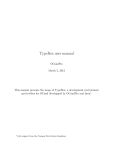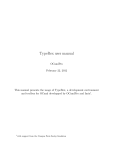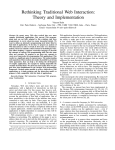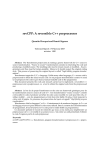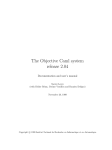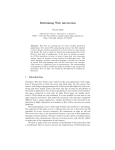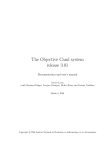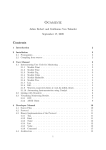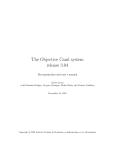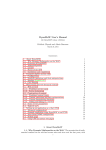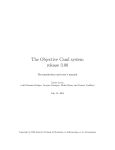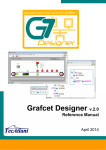Download TypeRex user manual
Transcript
TypeRex user manual
OCamlPro
March 13, 2012
This manual presents the usage of TypeRex, a development environment
and toolbox for OCaml developped by OCamlPro and Inria1 .
1 with
support from the Campus Paris Saclay fundation
Introduction
We present a new development environment which improves what was previously available
for OCaml, by bringing some of the features which are considered classic in editors for
mainstream programming languages.
The TypeRex environment for Emacs is written in OCaml and relies on parts of the
OCaml compiler to provide a more accurate semantic view of the OCaml programs which
are edited, enabling a set of specific commands and behaviors.
A few additional tools are provided together with the TypeRex environment, which
mostly serve to perform the necessary specific processing on the edited programs, namely,
provide appropriate binary annotations about the source files.
Summary of TypeRex features
• Improved syntax coloring
• Auto-completion of identifiers (experimental)
• Browsing of identifiers: show type and comment, go to definition, cycle between
alternate definitions, and “semantic grep”
• Strictly semantic-preserving, local and whole-program refactoring:
– renaming identifiers and compilation units
– open elimination and reference simplification
• Robust w.r.t. not-recompiled, possibly unsaved buffers
• Scalable (used regularly on a few hundreds of source files)
All the features of the Tuareg mode are also included, even when we provide an equivalent
of them.
3
4
Feedback
Please report any bugs, unexpected behavior, or unclear documentation, through the
Github issue tracker at https://github.com/OCamlPro/typerex/issues. Please let us
know also about your most wanted features so that we can optimize our agenda.
Contents
1 TypeRex setup
1.1 TypeRex distribution and supported environments .
1.1.1 System requirements . . . . . . . . . . . . .
1.1.2 Obtaining TypeRex . . . . . . . . . . . . . .
1.2 Installation . . . . . . . . . . . . . . . . . . . . . .
1.2.1 Build configuration . . . . . . . . . . . . . .
1.2.2 Building . . . . . . . . . . . . . . . . . . . .
1.2.3 Installation . . . . . . . . . . . . . . . . . .
1.2.4 Testing the environment . . . . . . . . . . .
1.3 TypeRex configuration (optional) . . . . . . . . . .
1.3.1 TypeRex keys and contextual menu . . . . .
1.3.2 Automatic indentation . . . . . . . . . . . .
1.3.3 TypeRex syntax coloring . . . . . . . . . . .
1.3.4 Auto-completion . . . . . . . . . . . . . . .
1.3.5 On-the-fly compilation . . . . . . . . . . . .
1.3.6 Reconfiguring paths . . . . . . . . . . . . . .
.
.
.
.
.
.
.
.
.
.
.
.
.
.
.
.
.
.
.
.
.
.
.
.
.
.
.
.
.
.
.
.
.
.
.
.
.
.
.
.
.
.
.
.
.
.
.
.
.
.
.
.
.
.
.
.
.
.
.
.
.
.
.
.
.
.
.
.
.
.
.
.
.
.
.
.
.
.
.
.
.
.
.
.
.
.
.
.
.
.
.
.
.
.
.
.
.
.
.
.
.
.
.
.
.
.
.
.
.
.
.
.
.
.
.
.
.
.
.
.
.
.
.
.
.
.
.
.
.
.
.
.
.
.
.
.
.
.
.
.
.
.
.
.
.
.
.
.
.
.
.
.
.
.
.
.
.
.
.
.
.
.
.
.
.
.
.
.
.
.
.
.
.
.
.
.
.
.
.
.
.
.
.
.
.
.
.
.
.
.
.
.
.
.
.
7
7
7
7
7
7
8
8
9
9
9
9
10
10
11
11
2 TypeRex development environment for Emacs
2.1 TypeRex environment setup . . . . . . . . . . .
2.1.1 Generating .cmt(i) files . . . . . . . . . .
2.1.2 Project configuration: .typerex file . . .
2.2 Browsing OCaml code with TypeRex . . . . . .
2.2.1 Grep (C-o g / C-o t g) . . . . . . . . . .
2.2.2 Goto-definition (C-o d) . . . . . . . . . .
2.2.3 Cycle-definitions (C-o a) . . . . . . . . .
2.2.4 Comment-definition (C-o c) . . . . . . .
2.3 Refactoring OCaml code with TypeRex . . . . .
2.3.1 Multiple-file undo (C-o u) . . . . . . . .
2.3.2 Renaming (C-o r / C-o t r) . . . . . . .
2.3.3 Reference pruning (C-o p) . . . . . . . .
2.3.4 Open elimination (C-o q) (for ”qualify”)
2.4 Syntax coloring . . . . . . . . . . . . . . . . . .
2.5 Auto-completion . . . . . . . . . . . . . . . . .
.
.
.
.
.
.
.
.
.
.
.
.
.
.
.
.
.
.
.
.
.
.
.
.
.
.
.
.
.
.
.
.
.
.
.
.
.
.
.
.
.
.
.
.
.
.
.
.
.
.
.
.
.
.
.
.
.
.
.
.
.
.
.
.
.
.
.
.
.
.
.
.
.
.
.
.
.
.
.
.
.
.
.
.
.
.
.
.
.
.
.
.
.
.
.
.
.
.
.
.
.
.
.
.
.
.
.
.
.
.
.
.
.
.
.
.
.
.
.
.
.
.
.
.
.
.
.
.
.
.
.
.
.
.
.
.
.
.
.
.
.
.
.
.
.
.
.
.
.
.
.
.
.
.
.
.
.
.
.
.
.
.
.
.
.
.
.
.
.
.
.
.
.
.
.
.
.
.
.
.
.
.
.
.
.
.
.
.
.
.
.
.
.
.
.
13
13
13
14
16
16
17
17
17
17
18
18
18
19
19
19
5
.
.
.
.
.
.
.
.
.
.
.
.
.
.
.
.
.
.
.
.
.
.
.
.
.
.
.
.
.
.
6
CONTENTS
2.6
.
.
.
.
.
.
19
19
20
20
20
20
3 TypeRex tools
3.1 ocp-type . . . . . . . . . . . . . . . . . . . . . . . . . . . . . . . . . . . . .
3.2 ocp-wrapper . . . . . . . . . . . . . . . . . . . . . . . . . . . . . . . . . . .
23
23
24
4 Common issues and questions
4.1 General . . . . . . . . . . . . . . . .
4.2 Project setup / building annotations
4.3 Browsing and refactoring . . . . . . .
4.4 Syntax coloring . . . . . . . . . . . .
4.5 Auto completion . . . . . . . . . . .
27
27
28
29
30
30
2.7
TypeRex assumptions and supported code . . . .
2.6.1 Preprocessors . . . . . . . . . . . . . . . .
2.6.2 Module packs . . . . . . . . . . . . . . . .
2.6.3 Dealing with outdated binary annotations
2.6.4 Permissive behavior . . . . . . . . . . . . .
Recovery and debugging . . . . . . . . . . . . . .
.
.
.
.
.
.
.
.
.
.
.
.
.
.
.
.
.
.
.
.
.
.
.
.
.
.
.
.
.
.
.
.
.
.
.
.
.
.
.
.
.
.
.
.
.
.
.
.
.
.
.
.
.
.
.
.
.
.
.
.
.
.
.
.
.
.
.
.
.
.
.
.
.
.
.
.
.
.
.
.
.
.
.
.
.
.
.
.
.
.
.
.
.
.
.
.
.
.
.
.
.
.
.
.
.
.
.
.
.
.
.
.
.
.
.
.
.
.
.
.
.
.
.
.
.
.
.
.
.
.
.
.
.
.
.
.
.
.
.
.
.
.
.
.
.
.
.
.
.
.
.
.
.
.
.
.
.
.
.
.
.
.
.
.
.
.
.
.
.
.
.
.
.
.
.
.
.
.
.
.
.
.
.
Chapter 1
TypeRex setup
This chapter describes the process of installing and configuring TypeRex from the sources,
on a Unix environment with OCaml already installed.
1.1
1.1.1
TypeRex distribution and supported environments
System requirements
• Linux (32-bit or 64-bit) or MacOS (tested with 10.6.8)
• OCaml ≥3.11.2
• Emacs (Tested with 23.2.1, does not work under X-Emacs, reported to work with
Aquamacs but with performance issues)
• Gnu diff, present in PATH
1.1.2
Obtaining TypeRex
We recommend using the compressed archive distribution of TypeRex.
Source archive
All versions of TypeRex can be found at http://www.typerex.org/.
1.2
1.2.1
1:
Installation
Build configuration
./configure [options]
Useful options (examples):
7
8
CHAPTER 1. TYPEREX SETUP
--bindir=/opt/typerex
--disable-version-check
do not check OCaml version (allows, e.g., ocaml-3.12.1-rc1)
--with-lispdir=~/.emacs.d
default is a system-wide installation path
--with-ocp-build=<command>
default is ’ocp-build’ if found, ‘pwd‘/boot/ocp-build.boot otherwise
--disable-auto-complete
default is to install Emacs auto-complete, unless found in lispdir
--enable-cmt
binary-annotate typerex sources (for typerex developpers)
You may also specify an EMACS variable, as:
1:
1.2.2
2:
./configure [options] EMACS=aquamacs
Building
make
1.2.3
Installation
3:
sudo make install
Append the contents of emacs.append to your ∼/.emacs:
4:
cat emacs.append >>~/.emacs
(or paste the contents where you like). The next section shows how to customize this Emacs
configuration in order to handle non-standard settings and to fine-tune various TypeRex
options.
Warning: TypeRex is incompatible with (the original version of) the tuareg-mode.
Do not enable both in your .emacs.
Optional: enabling typerex for additional source file extensions
By default, the auto-mode-alist settings in emacs.append automatically start the TypeRex mode for standard OCaml source file extensions. You can add more extensions by
writing, for example:
(add-to-list ’auto-mode-alist ’("\\.eliom" . typerex-mode))
Note that if you intend to use TypeRex on these source file for more than syntax coloring,
you will also need to register these extensions either globally by adding an option to the
server:
(setq ocp-server-command "ocp-wizard -add-impl-suffixes .eliom")
or in the project description (as explain later). This second option is necessary for OCaml
scripts which are detected with an interpreter directive on the first line.
1.3. TYPEREX CONFIGURATION (OPTIONAL)
1.2.4
9
Testing the environment
Open a .ml file inside emacs, and switch to the *Messages* buffer. If you see the line
“Connection established with TypeRex server”, the installation is OK.
1.3
TypeRex configuration (optional)
The following additional configuration is done through Emacs customizable variables, and
can be changed in two ways:
• By directly editing the .emacs file to change the values.
• Through the Emacs customization mechanism, by choosing “Customize TypeRex
Mode” under the TypeRex Menu. Remember to check your .emacs for duplicate
variable customization, because setq assignments are ignored when updating the
custom-set-variables expression. Also note that many changes require restarting
Emacs to become effective, or at least running M-x ocp-restart-server.
1.3.1
TypeRex keys and contextual menu
You may change the default prefix key (C-o) for calling TypeRex commands. Just add
the following to your .emacs:
;; Changing the TypeRex prefix key:
(setq ocp-prefix-key [(control j)])
The contextual menu can also be enabled when right-cliking ; it offers the same actions
as the keyboard shortcuts.
;; Uncomment to enable typerex command menu by right click
;;(setq ocp-menu-trigger [mouse-3])
1.3.2
Automatic indentation
TypeRex currently uses the Tuareg indentation mechanism. To get a result closer to the
OCaml programming guidelines described at http://caml.inria.fr/resources/doc/
guides/guidelines.en.html Some users prefer to indent slightly less, which is achieved
with:
(setq
(setq
(setq
(setq
typerex-let-always-indent nil)
typerex-with-indent 0)
typerex-function-indent 0)
typerex-fun-indent 0)
Another reasonable choice regarding if-then-else is:
(setq typerex-if-then-else-indent 0)
10
CHAPTER 1. TYPEREX SETUP
1.3.3
TypeRex syntax coloring
By default, TypeRex proposes a new syntax coloration for OCaml source files. You may
disable syntax coloring by setting ocp-syntax-coloring to nil instead of t. Alternatively,
you can change the coloring theme/implementation by customizing the variable ocp-theme.
Here are the possible values:
• "syntactic" (default): the new TypeRex coloring, providing extended identifier
kind distinction, and smarter comment/string handling
• "tuareg_like": The same TypeRex implementation, tuned to look almost like Tuareg mode (with minor improvements and differences, and with Tuareg faces renamed
into typerex-font-lock-. . . )
• "caml_like": Same as tuareg_like, with Caml-mode colors (not renamed)
• "tuareg" The embedded Tuareg-mode implementation of syntax coloring (again with
renamed Tuareg faces).
• "caml" The Caml-mode implementation of syntax coloring, which must be installed
and present in the path (file caml-font.el). You may need to add the following to
your .emacs:
(setq load-path (cons "~/.emacs.d/caml-mode" load-path))
1.3.4
Auto-completion
A (still very primitive) contextual identifier completion feature is provided, relying on the
Emacs Auto Complete Mode written by Tomohiro Matsuyama. It can be enabled by
uncommenting the following lines in .emacs:
;; AutoComplete
(add-to-list ’load-path "/usr/local/share/emacs/site-lisp/auto-complete-mode")
(setq ocp-auto-complete t)
;; Using <‘> to complete whatever the context, and <C-‘> for ‘
(setq auto-complete-keys ’ac-keys-backquote-backslash)
;; I want immediate menu pop-up
(setq ac-auto-show-menu 0.)
;; Short delay before showing help
(setq ac-quick-help-delay 0.3)
;; Uncomment to disable help showing
;;(setq ac-use-quick-help nil)
;; Number of characters required to start (nil to disable)
(setq ac-auto-start 0)
1.3. TYPEREX CONFIGURATION (OPTIONAL)
11
If you like auto-completion, you can enable it for all supported modes (using dictionaries):
;;;; Uncomment to enable auto complete mode globally (independently of OCaml)
;;(require ’auto-complete-config)
;;(add-to-list ’ac-dictionary-directories
;;
"/usr/local/share/emacs/site-lisp/auto-complete-mode/ac-dict")
;;(ac-config-default)
Warning! Do not set a black background using M-x invert-face default when using
auto-completion ; instead, start Emacs with emacs -r.
Auto completion keys
Changing the default keys and behavior can be useful to fit the user’s habits. For example, the provided configuration ’ac-keys-backquote-backslash keeps normal behavior
of TAB, RET, <up>, and <down>, and uses respectively <‘>, <\>, <C-p> and <C-up> instead,
remapping ’‘’ to <C-‘>.
On some keyboards, <2 > and <$> may be more appropriate than <‘>, <\>. This is
achieved by setting auto-complete-keys to ac-keys-two-dollar
Setting auto-complete-keys to nil will use the default auto-complete configuration,
that is, with TAB, RET, <up>, and <down>. Alternatively, one may want to use all standard
keys, but with auto-start disabled and using a specific trigger key.
;; Standard keys but starting only with C-TAB, and no auto-start
(setq ac-auto-start nil)
(setq auto-complete-keys ’ac-keys-default-start-with-c-tab)
Finally, you can also define a customized ’ac-keys-. . . function by looking at the implementation of predefined ones, or set the auto-complete configuration variables directly, but
then make sure to set auto-complete-keys to nil. See the Auto Complete Mode user
manual for more details on the corresponding configuration.
1.3.5
On-the-fly compilation
By setting ocp-flymake-enabled, you can enable an on-the fly compilation button, using
flymake and ocamlbuild (contributed by Wojciech Meyer). This feature and its assumptions
are undocumented.
1.3.6
Reconfiguring paths
The values of all the paths described in the following are determined at configure time, so
normally you should not need to change them, unless you didn’t perform the install step.
12
CHAPTER 1. TYPEREX SETUP
Emacs lisp directory
The directory in which the TypeRex (and auto-complete) lisp code is searched for is configured by the (add-to-list ’load-path ...) line in emacs.append. Note that if you ran
configure with default options the value should be /usr/local/share/emacs/site-lisp
which is in the default load-path, so this line is probably even not required.
TypeRex server command
The TypeRex development environment is implemented by means of a server which is
launched by Emacs. The command which is fed to the shell to launch the server is defined
by the variable ocp-server-command. You can use it for example to pass a particular
OCAMLLIB environment variable (see bellow) to the server. In a standard setup, the corresponding line in emacs.append is also not required as the default value is the executable
base name, and is searched in the path.
OCaml standard library
Most TypeRex executables (most notably the server) need to access the OCaml standard
library at runtime. They look at the following options, in decreasing priority order, to
determine the appropriate directory:
1. typerex-library-path, if specified in .emacs
2. OCAMLLIB environment variable
3. CAMLLIB environment variable
4. option ocamllib in ∼/.ocp/ocaml.conf
5. the value determined by the configure script when building typerex.
Chapter 2
TypeRex development environment
for Emacs
This chapter explains how to enable and use the TypeRex environment for editing an
OCaml program.
2.1
TypeRex environment setup
Using the TypeRex environment for an OCaml project requires two configuration steps: ensuring the generation of required binary annotations, and providing a minimal description
of the project’s paths. Those steps are detailed in the following.
Keeping binary annotations up-to-date
The binary annotations must be up-to-date for TypeRex to function properly, in particular
for refactoring, and these annotations are not updated by TypeRex itself. This implies that
successive refactoring actions require a recompilation of the impacted part of the program
at each step.
2.1.1
Generating .cmt(i) files
The most simple way of generating binary annotations is to setup your build process to
use the provided ocp-* versions of the OCaml compilers, for example ocp-ocamlc.opt
instead of ocamlc.opt. These are wrappers which behave as the original compilers, but
additionally run ocp-type on the sources.
In some cases, a more expressive solution is required which consists in prefixing the
compiler commands with ocp-wrapper -save-types with specific arguments (see chapter
“Tools” for more details).
Here are examples of how to achieve this depending on your build system.
13
14
CHAPTER 2. TYPEREX DEVELOPMENT ENVIRONMENT FOR EMACS
make
Use as compiler a variable defined by
OCAMLC=ocp-ocamlc.opt
or
OCAMLC=ocp-wrapper -save-types [<other options>] ocamlc.opt
ocamlbuild
Add
Options.ocamlc := S [ A "ocp-ocamlc"]
or
Options.ocamlc :=
S [ A"ocp-wrapper"; A"-save-types"; ... ; A"ocamlc"]
to your myocamlbuild.ml file. Another option is to invoke ocamlbuild with options:
ocamlbuild -ocamlc ocp-ocamlc.opt -ocamlopt ocp-ocamlopt.opt
Finally, don’t forget t add CMT _build to your .typerex file (see below).
ocamlfind (without ocamlbuild)
Add
ocamlc = "ocp-ocamlc.opt"
or
ocamlc(typerex) = "ocp-ocamlc.opt"
to your /etc/findlib.conf (or ocamlfind.conf, or the file pointed to by $OCAMLFIND_CONF).
The first option tells ocamlfind to use ocp-wrapper globally ; the second defines a toolchain ”typerex” which you then specify by calling
ocamlfind -toolchain typerex ocamlc
Using a separate build process
Alternatively, ocp-type provides a file Makefile.ocp-type.template, which is able to perform
the ocp-type compilation automatically for simple projects.
2.1.2
Project configuration: .typerex file
Most functionalities of TypeRex rely on some knowledge of the edited program (source
files, libraries. . . ) which should be specified in a very simple project file at the “root” of its
source tree with name .typerex. When TypeRex is invoked on a source file <file.ml>,
it looks for file .typerex in the directory containing <file.ml>, or its parent directories,
back to the file system’s root. This file is read at each command invocation (except syntax
coloring and auto-completion) so modifications are taken into account immediately.
2.1. TYPEREX ENVIRONMENT SETUP
15
Syntax of .typerex files
The .typerex file should specify the set of directories to search for OCaml source files,
and the set of directories to include in the load path (i.e., libraries). It is also possible
to exclude some source files or whole compilation units, or to force files to be included
whatever their extension (if any).
The syntax of the .typerex file is as follows:
<project file> := <line>* // file must end with a newline
<line> := <dirs>
| I<dirs>
|
|
|
|
|
|
-<files>
IMPL <files>
INTF <files>
CMT <dir>
NOSTDLIB
#<comment>
//
//
//
//
//
//
//
//
add all contained source files (non-recursive)
include <dirs> as external libraries
+<dir> means <stdlib>/<dir>
ignore these source files
treat these as implementation files
treat these as interface files
search .cmt(i)s here instead of in source dir
do not include the standard library path
<dirs> := white-space-separated list of directories
<files> := white-space-separated list of files
Relative directory names are interpreted with respect to the directory containing the
project file .typerex, and the project directory itself may be denoted by ’.’, but the
shortcuts ’∼’ and ’∼user’ are not supported. Note that -<prefix> is a shorthand for
-<prefix>.ml <prefix>.mli ... See .typerex in the TypeRex root directory for an
example.
Meaning of project and library directories
Lines starting with I indicate that the specified directories are considered as library and
not as project’s directories. The meaning of this distinction, which may change in the
future, is currently the following:
• All source files (.ml, .mli, .mll, .mly) in a project directory are considered, whether
they have corresponding compiled files (.cmi, .cmti, .cmt) or not, while compiled files
without sources are ignored. This is exactly the opposite for libraries: all .cmi, .cmti,
.cmt are considered, and uncompiled sources are simply ignored.
• Refactoring and browsing stops at the boundary of libraries, and no binding propagation is performed on the implementation of libraries (see the documentation for
renaming and grep). This saves some computation time and is sound unless a library
depends on the program (but the same question arises when the considered program
is meant to be a library)
16
CHAPTER 2. TYPEREX DEVELOPMENT ENVIRONMENT FOR EMACS
Pack modules (experimental)
Pack modules are understood by TypeRex if the source directories contain either a file
• pack.mlpack in the ocamlbuild format: a list of module names, possibly qualified
(using /) by a path relative to the directory containing the pack.mlpack file, or
• pack.cmt, whose contents is a pack module (such as generated by ocp-type -pack.
This option only works if the packed modules are in the same directory as the resulting
pack, which is not the case when compiling with ocamlbuild.
Other options
CMT <dir> syntax: It is possible to specify a CMT directory to search for .cmt(i) files
when they are not found at the same place as the source files. This is needed if the build
system moves the files around, but then if several modules (in different directories) have
the same name, then outdated cmts won’t be assigned unless there only is one (matching
with the source digest to resolve ambiguity).
IMPL <files>, INTF <files>: Use this to use TypeRex on source files with special
extension (or none). The subdirectory containing these files still needs to be specified in
the .typerex file. You will also have to enable TypeRex mode for those, either manually
with M-x typerex-mode, or by extending auto-mode-alist or interpreter-mode-alist
(see emacs.append).
NOSTDLIB: Do not implicitely include the standard library path. This is required when
using TypeRex on the OCaml compiler.
Fallback
If no specific configuration is provided, TypeRex considers as program the set of OCaml
source files present in the directory containing the edited source file, with no libraries other
than the OCaml stdlib.
2.2
Browsing OCaml code with TypeRex
Note on browsing commands: Each cursor motion incurred by a browsing action
(except when clicking on grep results) is undoable with the standard Emacs shortcut (C).
2.2.1
Grep (C-o g / C-o t g)
(C-o g) display a click-able list (compile minor mode) of the connected definitions and
occurrences of the identifier under the cursor. Invocation is the same as for renaming. Use
(C-o t g) to grep the top-level module defined by the current file instead of an identifier.
2.3. REFACTORING OCAML CODE WITH TYPEREX
2.2.2
17
Goto-definition (C-o d)
Places the cursor on the definition of the identifier under the cursor, opening the appropriate file in the current window if necessary.
2.2.3
Cycle-definitions (C-o a)
Places the cursor on an alternate definition of the identifier declaration under the cursor,
opening the appropriate file in the current window if necessary. The typical effect is to
switch between .ml and .mli files, but at the right place. This may be used only for top-level
let-bindings (i.e. ’let’ and not ’let..in’, external statements, type declarations, exception
declarations, and (recursive) module and module type declarations
2.2.4
Comment-definition (C-o c)
Display a description of the identifier under the cursor, with its lookup path, and any
comments associated with it (in the sense of OCamldoc). The description is:
• the type, for a value or field
• the type declaration, for a type constructor
• the argument types (or ”constant”), for a constructor or exception
• the module type, for a module or module type.
2.3
Refactoring OCaml code with TypeRex
Note on reverting and undoing: For all refactoring actions, the reverting of modified
buffers and the undoing take one of the two following modes:
• If the modification is local to the current buffer, then it is reverted while keeping
its history, and renamed if needed. This enables undoing with the standard emacs
shortcut (C- ).
• If several files are modified, then all relevant buffers are reverted and their “local”
undo-lists are cleared. Instead, the multiple-file modification is added to a global
undo list and can only be undone with “C-o u”. A call to “C-o u” is also pushed
onto the local undo lists of all modified buffers for convenience, so that (C- ) will also
work.
18
CHAPTER 2. TYPEREX DEVELOPMENT ENVIRONMENT FOR EMACS
2.3.1
Multiple-file undo (C-o u)
Undo the last multiple-file modification. Warning! This discards any subsequent modification of the affected files (a confirmation is asked in this case). All buffers editing one
of the affected files are reverted, and their local undo lists are cleared (and then receive a
single new “global-undo” item).
2.3.2
Renaming (C-o r / C-o t r)
Rename an identifier through an OCaml program.
(C-o r): The cursor must be placed on an identifier definition or reference (for example,
a let binding or a pattern).
(C-o t r): Rename the top-level module defined by the current file instead of an identifier.
Renaming takes care of necessary propagation (e.g., when distinct values with the same
name need to be renamed consistently because this name appears in a common interface),
and capture is detected.
Renaming is implemented for: values, types, modules (non-recursive), module types,
fields, constructors, and exceptions. Aa a convenience, a partial, unsound renaming of
classes and class types is supported, but will miss all references to the “secondary” bindings
of a class or class type, i.e., the closed and open types, and, for a class, the class type.
Type variables, instance variable, methods, argument labels, and polymorphic variants are
not supported.
The replacement is intended to be complete, up to the following known bugs:
• labels, e.g. renaming x in let x = .. in f ∼x yields f ∼y instead of f ∼x:y, and
similarly with fun ∼x -> ..
• renaming a type which is in fact a class or a class type, or such that its renaming
“propagates” to one (through module constraints and functor applications) will not
rename the class or class type itself, or its references.
Note also the following limitation:
• including a module where an element is renamed with an afterwards masked name
causes a capture error.
2.3.3
Reference pruning (C-o p)
Simplify the identifier references (longidents) by removing unnecessary qualification. This
operation ranges on the current buffer.
2.4. SYNTAX COLORING
2.3.4
19
Open elimination (C-o q) (for ”qualify”)
Remove (if possible) the open statement under the cursor and qualify the subsequent
references as required. the let open .. in syntax is also supported by open elimination.
This operation is currently slightly conservative, when the same module is opened again
inside one of the items in the elimination scope (sub-modules, let open, and M.(...))
but a duplicate open at the same level will be correctly handled.
2.4
Syntax coloring
TypeRex implements its own version of syntax coloring. It is not yet fully stable, but
already has some new features such as the inline marking of lexing errors (with help-info)
and a smarter treatment of unterminated strings and comments.
Syntax coloring is not specialized for ocamlyacc/ocamllex files, but will usually give an
acceptable result except for C-style comments.
2.5
Auto-completion
An experimental completion feature is proposed in typerex, currently only for identifiers
(including methods, tags, labels and type variables). Once enabled, a menu of candidates
is triggered when typing test or with the appropriate key (<‘> by default) which also
completes the longest common prefix. Other keys allow to select a candidate and insert it
(<C-n>, <C-p>, and <\> by default), or to cycle between them (with <TAB>, see the Auto
Complete Mode user manual).
The candidates computation takes into account the load path which is configured for
the project, the open and include statements and unqualified identifiers until the current
position in the edited file (in a very approximative and simplistic way) and the module
qualification possibly prefixing the identifier to be completed.
2.6
2.6.1
TypeRex assumptions and supported code
Preprocessors
The browsing commands of TypeRex support ocamlyacc/ocamllex sources, and should
work with other pre-processors which generate OCaml source files with appropriate line
numbers directives. More precisely, the identifiers in a pre-processed source file which are
actual identifiers of the source (i.e., not generated or transformed during pre-processing)
should be OK to grep or jump from and to, if no generated code has the same location.
For ocamlyacc and ocamllex files, these ”actual” identifiers correspond to the quoted
OCaml code (between braces). Jumping to ocamlyacc entry points is not supported however, because the generated interface has no line number directives. Renaming may work
20
CHAPTER 2. TYPEREX DEVELOPMENT ENVIRONMENT FOR EMACS
in pre-processed or ocamllex/ocamlyacc source files, but has not been thoroughly tested.
Other refactoring commands won’t work on ocamlyacc/ocamllex sources.
The camlp4 pre-processor (version 3.12.1) is supported, but only partially because its
output is an ast which has insufficient location information (or a source file but without
line numbers directives). ocp-type (or ocp-wrapper) can generate binary annotations with
camlp4, but the result of TypeRex commands will sometimes be inaccurate on camlp4processed sources (in particular, renaming should only be attempted for local or unexported
value bindings).
2.6.2
Module packs
Module packing is supported to the extent of its treatment in the project description (see
above), but is still experimental (and with the limitation that “goto” does not go through
packs while “grep” does, as for include directives).
2.6.3
Dealing with outdated binary annotations
TypeRex is usually able to overcome sparse changes to the edited files (saved or not) w.r.t
the last compiled version, and to recompute the right positions. This feature relies on
the source snapshots which are embedded in .cmt files. This works also for refactoring
commands, but in this case a confirmation will be asked before proceeding.
2.6.4
Permissive behavior
Some internal errors which could occur while processing some files (for example due to
unhandled language features) may be caught and reported to the user (asking for a confirmation in the case of refactoring). This avoids giving up too soon on errors which are
clearly harmless to a specific action.
2.7
Recovery and debugging
Except for restarting the server, this section is more intended to developing and debugging
TypeRex.
Errors and server restart
If the OCP server crashes for any reason (or becomes crazy), it is possible to restart it
using
M-x ocp-restart-server
2.7. RECOVERY AND DEBUGGING
21
Logging:
First, the TypeRex environment for Emacs will echo minimal information as messages in
the mini-buffer, the history of which is kept in the special buffer *Messages*. This includes
the startup procedure, feedback about the executed commands, and in case of unexpected
error (which is a bug), a complete exception backtrace.
You may enable logging of debug information in ∼/.ocp-wizard-log by setting the
ocp-debug variable to t (the trace will be huge and hard to read). The value of ocp-debug
may also be a string, which is a comma-separated list (without whitespace) of uncapitalized
module names in the TypeRex code.
Fail fast
In the context of debugging, it is usually easier to disable most exception handling to get a
backtrace closer to the real problem. This can be done by setting ocp-dont-catch-errors
to t. Note however that this will lead TypeRex to fail in cases which would normally have
triggered tolerant behavior.
Profiling
TypeRex may dump profile information in ∼/.ocp-wizard-profile.out if ocp-profile
is set to the name of a TypeRex command (see tools/ocp-wizard/main/owzServer.ml).
Run profile ∼/.ocp-wizard-profile.out to generate a dot file (note that profile is
not compiled or installed by default).
22
CHAPTER 2. TYPEREX DEVELOPMENT ENVIRONMENT FOR EMACS
Chapter 3
TypeRex tools
This chapter summarizes the command-line tools which are provided together with the
TypeRex environment.
3.1
ocp-type
The ocp-type command-line tool is the “type-only” OCaml compiler which is used to
extract the binary annotations needed by the TypeRex environment. It may be invoked
directly or through the ocp-wrapper tools (see below). It accepts the same options and
arguments as ocamlc, and the specific option -save-types, to actually write the binary
data to a file.
Pre-processing
ocp-type also accepts pre-processors through the -pp option, which should output either
• an OCaml source file (if possible with line-number directives to allow an accurate use
of TypeRex), or
• an OCaml dumped AST of one of the supported versions (this is the default behavior
of camlp4), or
• a Camlp4 dumped AST of one of the supported versions, which can be achieved by
passing the option -printer Camlp4AstDumper to camlp4 (this is done automatically
if you use ocp-wrapper).
Note that the third option is better than the second one with respect to locations (the
accuracy of which is instrumental to TypeRex working).
Libraries
ocp-type accepts the special form
23
24
CHAPTER 3. TYPEREX TOOLS
ocp-type -save-types -a <units> -o <target>
where
• the argument units may be cmi, cmo, cmti, cmt, mli, or ml files, and
• the target is ignored.
Only arguments ending in ml or mli will be considered, and typed into cmt or cmti files.
Module packs
ocp-type accepts the special form
ocp-type -save-types -pack <units> -o <target>
where
• the argument units may be cmi, cmo, cmti, cmt, mli, or ml files, and
• the target may be a cmo or cmt file.
Howerver, input will always look at cmt or cmti (or cmi as a fallback) files (possibly
generating them if ml or mli are given), and the output will always be written in a cmt
file. If a mli file exists for the name of the pack, then ocp-type will look for a compiled
interface file for it in cmti format (or cmi as a fallback) and match the result of packing
the arguments against this signature.
3.2
ocp-wrapper
The command ocp-wrapper and the specialized commands ocp-ocamlc, ocp-ocamlopt,
ocp-ocamlc.opt, and ocp-ocamlopt.opt simplify the generation of binary annotations
by invoking ocp-type with the appropriate options, as part of the usual compilation commands. Calling
ocp-wrapper -save-types <command> <options and arguments>
where <command> is one of the OCaml compilers first invokes this compiler with the exact
same options and arguments, and then runs ocp-type (unless the command-line was a
linking-only phase) with the right options and arguments which are deduced from the
original command ones.
Shortcuts
The four ocp-* commands are shortcuts for ocp-wrapper -save-types <command> which
are useful when a single executable program is required as compiling command.
3.2. OCP-WRAPPER
25
Options
• -with-ocp-type, -with-ocamlc, . . . : allow to customize the ocp-type, ocamlc,
. . . commands which are run.
• -v print the ocp-type command which is executed on stderr.
Pre-processing
Any -pp option appearing in the command line is transformed as follows when passed to
ocp-type:
• if the pre-processor command is (a variant of) camlp4, and unless option -no-wrap-camlp4
is passed to ocp-wrapper, then the option -printer Camlp4AstDumper is added,
which yields more accurate location information,
• otherwise, the command is left unchanged.
Libraries and Module Packs
ocp-wrapper accepts the special forms
ocp-wrapper -save-types <compiler> -a <units> -o <target>
ocp-wrapper -save-types <compiler> -pack <units> -o <target>
Arguments and targets ending in cmx are converted into cmo and targets into cmt as
appropriate (see the documentation for ocp-type).
26
CHAPTER 3. TYPEREX TOOLS
Chapter 4
Common issues and questions
4.1
General
Reporting bugs
Bugs reports should be sent through the issue tracker at https://github.com/OCamlPro/
typerex/issues (or by mail). If the problem is an uncaught exception (of the form
“Error:. . . ”), make sure to provide the full backtrace (available in the *Messages* buffer).
In addition to the action which triggered the problem, an accurate description of your code
(and configuration) will be helpful, especially for a wrong result (for example, incomplete).
How are caml-mode, tuareg-mode, and TypeRex related
• caml-mode is the original Emacs mode for OCaml, providing indentation, syntax
coloring, interactive interpreter and debugger support, and some semantic-level functions using .annot files.
• tuareg-mode (mostly) improves the caml-mode, re-implementing several features,
but may use some functions of caml-mode if present (from caml-types and camlhelp).
• The Emacs version of TypeRex (which is currently the only one available) builds
on the tuareg-mode (which is included up to a few modifications and a systematic
renaming), providing additional functions (and offering an alternative for syntax
coloring). It should not be enabled as the same time as the original tuareg-mode in
your.emacs, or conflicts will arise. Optional interaction with the caml-mode should
behave exactly the same, but has not been tested, except for syntax coloring.
27
28
CHAPTER 4. COMMON ISSUES AND QUESTIONS
What about prior Caml-mode/Tuareg-mode customization
As explained above, since TypeRex embeds the Tuareg mode, with functions typically
renamed from tuareg-. . . to typerex-. . . , you should make sure to disable Tuareg when
using TypeRex, to avoid risking conflicts. Furthermore, if you previously customized these
modes (e.g., indentation or coloring settings), you can probably just replace the appropriate
names in your existing configuration. See the manual about getting Tuareg-mode colors.
To use the Caml-mode for coloration instead, you can just add the following to your .emacs
(replacing the caml-mode path):
(setq ocp-syntax-coloring nil)
(setq load-path (cons "/path/to/the/caml-mode" load-path))
(if window-system (require ’caml-font))
(add-hook ’typerex-mode-hook ’caml-font-set-font-lock)
What about other editors and operating systems
Eclipse support is planed in a near future. Some people have also expressed interest in VIM support, so
we pay attention to this too. Windows support is also planed (there may not be a lot of work to do for
that).
How does it compare to other similar tools
Many other tools exist to improve the development in OCaml, and it is not possible to describe each of
them here. Generally, we believe the refactoring and semantic grep capabilities of TypeRex to be the
most advanced, (except for the particular case of Oug, whose very expressive graph description allows
similar queries). Identifier querying is slightly more powerful and robust than its equivalents in, e.g.,
Tuareg, OCamlSpotter, or OcaIDE, with some minor differences in user interface choices. TypeRex does
not yet have graphical summaries as in ODT or OCaIDE, or build management. Syntax coloring is more
detailed and systematic than other solutions. Auto completion is currently restricted to identifiers (and
very approximate for local identifiers), and does not support syntactic constructs such as pattern matching
(as was proposed in OcamlWizard and the latest version of OCamlSpotter), but it is already quite accurate
and responsive on identifiers defined in other modules.
4.2
Project setup / building annotations
Findlib configuration does not work
We are investigating possible issues with findlib itself.
How to use TypeRex with Ocamlbuild projects
First, see the setup instructions on how to generate the .cmt(i) files (this usually amounts to calling ocamlbuild -ocamlc ocp-ocamlc.opt -ocamlopt ocp-ocamlopt.opt). Then add a line reading
CMT _build to your .typerex file.
What are .cmt(i) files exactly required for
The binary annotations provide a semantic descriptions of (type-able) source code, together with accurate
location information. They are used to know about binding in a large sense, for example applying a functor
to an argument somehow “binds” the functor’s parameter’s signature members to the actual argument’s
members. Navigation and grep will only range over binary-annotated code, which can generally depend
4.3. BROWSING AND REFACTORING
29
on libraries without requiring annotations for them, as long as cmi files are available (with some loss of
completeness though). Completion can use .cmi or .cmt(i) files, but the latter (and access to the source
code) will enable comment showing. Syntax coloring does not require any annotation at all, of course.
How to enable TypeRex for developping the OCaml compiler
Just copy this patch into the main directory, and run patch -p0 -i ocaml-typerex.patch, then rebuild
the compiler starting from the standard library (mandatory): make clean, make world, . . . Please note
the following limitations:
• ocp-type will fail on camlp4 except for version 3.12.1 (for binary compatibility reasons). This does
not impact the use of TypeRex for the remaining of the compiler.
• Including Camlp4 in the program is currently not possible.
• Generated files (other than ocamllex/ocamlyacc) are not detected, so don’t expect a fully automatic
renaming of e.g. List.iter.
• The Dynlinkaux pack module is not correctly understood by TypeRex (because its components are
in another directory).
4.3
Browsing and refactoring
{module, value, . . . } x not found [in load-path]
This means that some identifiers could not be resolved, and can occur in many situations. For a toplevel
module, this probably means a configuration problem (check your .typerex).
Grep, Cycle, and renaming sometimes lag
These command can take up to several seconds on large projects, because some computations have to
be done over the whole code. Most of it is cached, though, to speed up subsequent invocations (caching
should be correctly invalidated on a cmt file basis).
“Goto definition” fails, but “Grep” finds the definition
This is expected if the identifier comes from, for example, an included module, or a pack module (more
generally if the identifier is internally renamed by the OCaml compiler during type inference). The grep
(or renaming) algorithm takes these renamings into account to collect the full set of relevant identifiers,
so it is currently more powerful.
Locations are shifted, TypeRex complains about unsaved files
TypeRex uses the Emacs auto-save mechanism to know about modified buffers, so that it can usually realign shifted positions correctly. This is not a perfect solution though, and in particular, possible auto-save
files (#file.ml#) from older sessions will confuse TypeRex, if they are more recent than the file itself. In
this case you should delete them.
How does TypeRex deal with multiple toplevel modules with the same name
TypeRex was designed with this issue in mind, and uses full-path identification of toplevel-modules, together with a careful multiple load-paths management and digest-based cmt assignment. However, the
30
CHAPTER 4. COMMON ISSUES AND QUESTIONS
currently limited project configuration file typerex lacks expressiveness to accurately describe such settings (the load path is the same for all source files) so this is not yet fully supported (and more testing is
required). For example, TypeRex should typically be able to deal correctly with multiple Main modules
(if no other module depends on them), but not with multiple Misc or Util modules.
4.4
Syntax coloring
Coloring is sometimes inaccurate
The current implementation has exact lexing information, but only uses heuristics for approximate syntax
computation (because it needs to work for syntaxically incorrect buffers). This solution is not perfect and
also suffers from some thresholds which are introduced to keep it responsive enough.
4.5
Auto completion
Completion is inaccurate for definitions in the current buffer
The current implementation of completion is semantic for external compilation units (i.e., with a .cmt(i)
or .cmi, but only lexical for the current buffer, so this is expected.
Completion stops working
We still have to spot the cause of this problem. Reverting the current buffer with M-x revert-buffer
(after saving the file, of course) should bring it back.
Emacs deadlocks
This was a known bug, which used to happen when typing during a buffer’s initialization unless disabling
ocp-pre-cache, but should be solved now (let us know if you see it again). The solution is to run
killall ocp-wizard to kill the TypeRex server process (which unlocks Emacs) and then restart it from
the TypeRex menu.






























